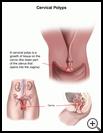
Cervical Polyps
________________________________________________________________________
KEY POINTS
- Cervical polyps are a growth of tissue on the cervix, the lower part of the uterus that opens into the vagina.
- Your healthcare provider will painlessly remove most polyps in the office and send the tissue to a lab for tests to make sure it is not cancer.
- Get a pelvic exam as often as recommended by your healthcare provider.
________________________________________________________________________
What are cervical polyps?
Cervical polyps are a growth of tissue on the cervix. The cervix is the lower part of the uterus that opens into the vagina. The uterus is the muscular organ at the top of the vagina. Babies grow in the uterus, and menstrual blood comes from the uterus, through the cervix.
Women of any age may have cervical polyps.
What is the cause?
The exact cause of cervical polyps is not known. They are not related to sexually transmitted diseases and infections (STDs and STIs) and are very rarely related to cancer.
What are the symptoms?
Cervical polyps often do not cause any symptoms. You usually cannot feel or see them. Sometimes they may cause bleeding between menstrual periods, especially after sex.
How are they diagnosed?
Your healthcare provider will ask about your symptoms and medical history and examine you. You will have a pelvic exam and possibly a Pap test. Most cervical polyps are discovered during a pelvic exam or with exams for causes of unusual bleeding.
How is it treated?
Polyps seldom develop into cancer of the cervix. However, the only way your healthcare provider can be sure that a polyp is not cancer is by removing it and looking at the tissue in the lab.
Most polyps are removed. Your healthcare provider usually will be able to remove the polyps painlessly. Your provider may scrape the base of the polyp to make sure the entire polyp is removed. A type of paste may be put on your cervix if there is any bleeding. The tissue that was removed will be sent to a lab for tests to make sure it is not cancer. This procedure can usually be done in your provider's office.
If the polyp is not removed:
- It may keep growing.
- It may cause bleeding between menstrual periods or after sex.
- It may be harder for you to get pregnant.
How can I take care of myself?
After treatment for cervical polyps, get a pelvic exam as often as recommended by your healthcare provider. Tell your healthcare provider if you have bleeding after sex, between menstrual periods, or after menopause.

